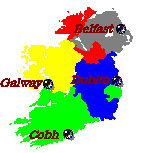TidesOther Pages | Geography Index Page
Bray is beside the sea where the rise and fall of the tides changes from day to day. Tides are caused MOSTLY (other reasons) by the pull of the moon and less by the pull of the Sun. 
There are two things you will notice if you watch tides TimeThe times when the tide is highest and lowest change from day to day. And the time of the tides is very different on the same day at different places around Ireland as you can see from the table. 
Tide Height
Some days the tide rises and falls more than on other days when the tide rises and falls less. This happens because when the Sun and Moon pull together the tide rises and falls more. Some of the time the Sun and Moon don't pull together and the tide doesn't rise and fall as much. Another factor is that each month as the moon goes around the Earth sometimes it is nearer to the Earth and sometimes further away. When the moon is nearer its gravity pulls more strongly and causes higher (and lower) tides.
The pictures above show details of tides (in Dublin) in September 1998 when the sea rises and falls most ..... and least.
The Sun, the Moon and the Earth
All of the possible changes in the movements of the Earth, Moon and Sun take 19 years to work themselves through before they start all over again. Causes of Tides
Encarta Tide InformationThe tide tables are available from the University of South Carolina, USA which provides tide predictions in a variety of formats. If you would like to see a graph of the tides for Dublin click HERE during summer time or HERE during winter time. X Tide programX Tide is a Unix program for predicting tides written by Dave Flater (this took years to perfect). A Windows version has been written by Michael Hopper (this only took him 600 hours to do!). Both of these programs are freeware. The Windows version is excellent and can calculate tides for just about anywhere including lots of places around the coast of Ireland. You can get all the info on X Tide by clicking HERE. As will be seen on the FAQ (frequently asked questions) page there is a version of Xtide available for Windows PCs.Obtaining WXtide32For information and download of a Windows version of X Tide click HERE.Other causes of rise in sea level
WindWhere very strong winds act on a stretch of water over a long distance they "pile up" water against the coastline they are blowing towards, causing an increase in sea level of several feet. This rise is called a tidal surge. DepressionsThe air above us presses down with an average force of 1,000 hPa. In depressions (Lows on the weather map) the air presses down with less force. This allows the sea to rise. StormsStorms are usually caused by depressions and so during a storm if the wind piles up the sea against the coast and the sea rises as a result of lower air pressure there may be a significant rise in sea level. If this happens at a particularly high tide there may be flooding as happened in the Netherlands in January 1953. Large parts of the Netherlands are very low lying and are protected from the sea by dykes. In January 1953 a combination of high tide, tidal surge and low air pressure during a storm caused the sea to rise 3 metres above normal high tide, the North Sea rose above the dykes, streamed across the country and 1,600 people lost their lives. WAM - Wave Height predictionsAbove taken, loosely, from Brendan McWilliams Weather Eye column in the Irish Times of Saturday 31 January 1998.
Other Pages | Geography Index Page | Top of Page |
|||||||||||||||||||||||||||||||||||||||||||||||||||||||||||